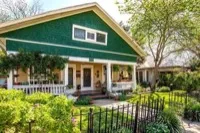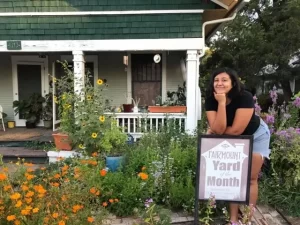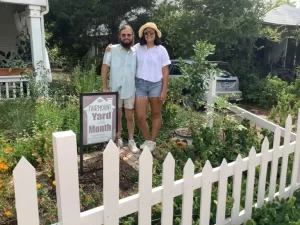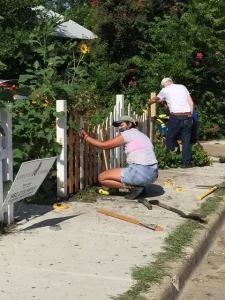1213 Carlock St – Yard of the Month (August 2020)
June 12, 2021
Yard of the Month
August 2020 Winners of Yard of the Month are Rachel and Joe Robinson of 1213 Carlock.
The Robinsons are just the third family to own the home since it was built c. 1915. Asked to name the features that initially attracted them to the house, Rachel pinpointed its historic charm, and secure, homey feel. She enjoys sharing the home with her husband and one of her brothers. Many Fairmounters will recall that 1213 Carlock was on home tour twice in the mid-2000’s, and will remember the distinctive open shelving in the kitchen, gracious room-to-room flow of the floor plan, and original woodwork and floors, as well as prior owner Ashley Rihel’s collections of vintage glass, china and Art Deco pottery.
The first recorded owner of 1213 Carlock was Walter Charles Crain, who was born in 1888 in Greenville, Texas to parents from Tennessee. By 1910, Walter’s parents had passed away, and at just 22, he was responsible for raising his teenaged brothers Henry and Sammy, then 19 and 17. He moved his brothers to Fort Worth, where they all lived in one room they rented from the Crume family at 2610 Refugio Ave., near the Stockyards (1910 US census). Walter got a job working as a fireman for the Frisco Railroad Company, which he kept for 42 years; he also joined the Brotherhood of Firemen and Locomotive Engineers. His younger brother Henry worked at the city Water Works plant and Sammy got a job in the Swift meat packing plant, which had opened in 1902 to much fanfare, and with the help of a giant tax break, a few steps from their boarding house (Hometown by Handlebar). Along with Armour meat packing and McNeil Libby, the meat packing industry drew 73,000 new residents to Fort Worth between 1902 and 1910 (Fort Worth History). Also around 1910, Walter married Irma Clifford Dodd of Bright Star, Arkansas (1891-1990), and they moved into a rented apartment at 1921 Washington Ave, (which was torn down after a major fire in the 1990’s) where they had two sons, Homer Lee (1910-1988), Clyde Virgel (1912-1982). Around 1915, they purchased the home at 1213 Carlock, just in time to bring home a new baby girl they called Lillian Geraldine (1915-2010), followed in five years by their youngest daughter, Virginia Dare (b. 1921).
Crime and personal safety are hot topics for Fairmount and Ryan Place residents today, and consume a lot of space on the Fairmount and Ryan Place Facebook pages. They also dominated local news in the 1930’s. The Fort Worth Star Telegram details how, on March 10, 1936, Mrs. Irma Crain of 1213 Carlock suffered a brutal attack at E. M. Daggett Elementary and Middle School at 2315 College Ave, where she had walked 0.4 miles — about an 8 minute journey– to collect her youngest daughter, Virginia, from an evening rehearsal. (Daggett Middle School on Carlock, now located directly across the street from the Crain’s home, had not yet been built). When Virginia came home alone without Mrs. Crain an hour later than expected, second son Clyde Crain set out in the car with his wife, Marguerite, and brother Homer’s mother-in-law, Mrs. Luda Turnage, to look for her. While en route to Daggett, Clyde spotted a woman, barefoot and bloodied, stumbling up Elizabeth Ave. He stopped to render aid and was astonished to find that the distressed woman was his own mother. Mrs. Crain had been attacked with an ice pick, dragged behind the school and assaulted, and was bleeding from serious wounds in her mouth and neck. The Crains called the hospital, the police, and the family doctor. Police were able to recover the ice pick from the Daggett school grounds, while Mrs. Turnage accompanied Mrs. Crain to the old JPS hospital on St. Louis Ave. and helped her with her paperwork and police interview. Irma Crain not only recovered from her serious injuries, but also survived a highly public and contentious trial in the spring of 1936, in which mistaken identity was a contested point in the trial, with several witnesses, including Mrs. Turnage, testifying that Texas sent the wrong man to the electric chair (Fort Worth Star Telegram). After her trauma and recovery, Mrs. Crain continued to live at 1213 with most of their adult children, and some of their spouses. Daughter Lillian lived in the front bedroom with her two young sons while husband Wilbur Barney served in the army in WWII. Clyde and his wife Marguerite lived in a rear garage apartment, while Homer and wife Carolyn Turnage Crain moved to San Antonio. Walter lived in the house on Carlock until his death in 1954, and Irma continued there for another 20 years, until she sold the house to the Walls family in 1975.




The Crain’s oldest and youngest children, Homer (l) and Virginia (r.) who grew up at 1213 Carlock. Sources: Central High School yearbook, 1929, and Pascal High School Yearbook, 1940.




(l) 1213 Carlock as a rental property in the 1990’s. Source: Fairmount National Historic District Photo Gallery. (r) 1213 Carlock in 2016. Source: Fairmount National Historic District Photo Gallery
The next owner, Saint Elmo Walls (1910-1995), the 5th of 9 children, was originally from Blum, Hill County, TX. Elmo, as he was known, lived with his wife Betty and daughter Linda at 1208 W. Jessamine. They purchased the Carlock house as a rental property, adding it to their portfolio of several rental properties on Jessamine and Carlock. Betty passed the home to her daughter Linda Walls Rihel, who married John Rihel, formerly of 6th Avenue. When their son Ira Rihel was old enough to marry and take over the property, he and wife Ashley made restoration of the bungalow their passion project for nearly a decade. Ira removed the walls to reveal the generous front porch with two front doors, replaced an attic vent with beautiful leaded glass windows, and added a decorative iron fence.
The home is currently painted dark green, but the Robinson’s are planning to paint it some historic shades of amethyst and lilac when they’ve completed current repairs to the soffits, fascia and shingles. In the front yard, next to the driveway, prior owner Ashley Rihel planted a pink climbing “Peggy Martin” Rose, which famously was the only one of the few rose varieties to survive flooding in southern Louisiana wake of Hurricane Katrina in August 2005, according to the Historic Rose Society of New Orleans. She also planted liriope along the iron fence line for the quintessential English cottage garden style. The Robinsons replaced the Rihel’s metal barrier with a wooden picket fence, painted a very pale pink, and transitioned to a garden of Texas natives which tolerate heat and drought well. Recently, half their fencing was damaged by a vandal who drove a truck through it, but they quickly found neighborhood aid to make repairs. Fairmount work group members Joe Hyun, Fred Harper, and Deanna Stuart gathered to help them rebuild and then paint the new pickets. Luckily, their sturdy native plant collection recovered well from the trauma.
Rachel, who describes herself as a “maximalist,” has removed much of the sod grass from the front yard and planted the space with a dozen daisy-like flowers from red to orange to yellow and pink, including Four-Nerve Daisy, Copper Canyon Daisy, Englemann’s daisy, multiple types of echinacea, and coreopsis. Just inside the fence, tall sunflowers currently bloom, where a profusion of red poppies dominated in May. Next year, Rachel plans to swap poppy seeds with near neighbor and past YOTM winner Susan Taylor Harper, who grows pink poppies each spring. The right-hand side of the yard also features a red Turks’ Cap, purple spires of Obedient plant, blue mist flower (Conoclinium coelestinum) a delicate-looking bloom which is quite hardy in hot Texas summers. They also plant native ornamental grasses, a large herb garden, pomegranate, and persimmon trees in the ground and lemon and pumello trees in pots. Rachel writes, “my favorite aspect of the garden is the food scaping, there are peppers, okra, tomatoes and greens stuffed in every little nook between the perennials. I also have a passion for fresh cut flowers and grow to sustain that habit.”
On the left-hand bed, we find the Peggy Martin rose and several types of ornamental tree: a lime tree in a turquoise pot, a Texas redbud flanking the driveway, and a gingko biloba (or maidenhair tree), with its distinctive fan-shaped leaves covered by a red-and-white beach umbrella to avoid damage from hot afternoon sun. The gingko, a favorite for Craftsman bungalow gardens in the Midwest, was a mutual anniversary gift for the couple. In fall, the leaves turn a beautiful saffron color, and in spring, it bears a translucent fruit (called a nut) resembling a small apricot. They also have two large okra plants with beautiful hibiscus-like flowers. Nearer to the porch, there are several low shade plants, such as shade-tolerant favorite oxblood purple oxalis triangularis, and several food crops like sorrel and mustard greens.
In the back yard, Joe and Rachel put in four raised vegetable beds for growing still more herbs and produce, including basil, tomatoes, pepper and chives. One of their best crops, though, came from throwing down a feed mix for their pet tortoise, which produced enough radishes and greens to get them through the spring’s pandemic shutdown. Future plans include removing an addition to the rear of the house which is not in good condition and blocks light from reaching the home’s interior, adding a greenhouse near the property line, and restoring the generous garage with its 1930’s apartment.






For their beautiful yard and their community spirit, our thanks, and a $25 gift card to Magnolia Ave’s Stir Crazy Baked Goods, go to the Robinsons.
Works Cited
Bussell, Gene B. “The Rose that Survived Katrina.” Southern Living. September 2007. Print.
US Army Conscription records, 1942.
Fairmount Photo Gallery. Fairmount National Historic District. Web.
“Jury Deliberates Less than 20 Minutes.” Fort Worth Star Telegram. 8 April 1936. Print.
Sanborn Fire Maps, 1951.
“A Slow Swift Death: The Rise and Fall of a Meat-Packing Plant.” Hometown by Handlebar: Cowtown as seen from a very narrow bicycle seat. Blog post. August 8, 2019. Web.
US Census years: 1910, 1920, 1930 and 1940. UScensus.gov. Web.
- Share
